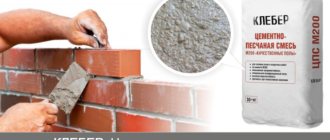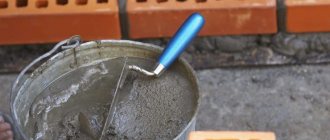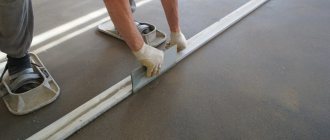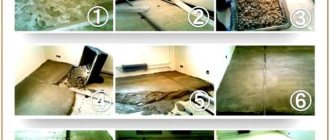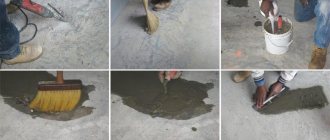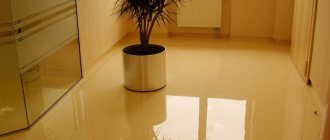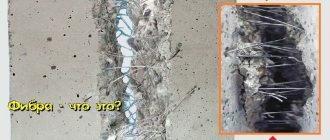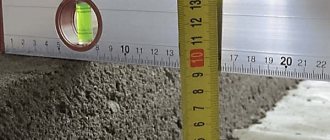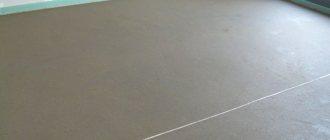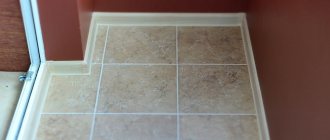Floor screeding is done in order to obtain a flat base for floor coverings. A solution of sand and cement is considered reliable and cheap. However, builders recommend using this mixture in single-story buildings or structures with strong interfloor ceilings, since the hardened mortar has a lot of weight and can affect the structure of the building. To prevent this from happening, you should follow the proportions and calculate the consumption of DSP for floor screed.
Construction of sand concrete screed
This material is mainly used to form floor screeds. Because cement mixtures of this type are easy not only to use, but also to produce. And if earlier for this they prepared a concrete solution based on cement, sand and crushed stone, which was diluted according to the requirement, today manufacturers offer a dry ready-made mixture with the exact amount of components added to it. Hence the high quality of the screed and the guarantee for its long-term operation.
Advantages and disadvantages of using the material
The biggest advantage of this building material is its practicality and high ease of use. Positive qualities can be added:
- excellent tensile and bending strength;
- if you add additives to the mixture, you get a material with the required characteristics;
- tolerates vibration well;
- the structure is homogeneous, which indicates high quality.
Sand concrete also has its disadvantages:
- since this is a material based on water, cement and sand, it shrinks during the drying process;
- screeds made from it are difficult to process;
- The consumption of sand concrete per 1 m2 of surface being poured is high due to the high cement content in the mixture.
The last point is important. Therefore, when purchasing this dry mixture, it is necessary to carry out calculations so as not to overpay. In addition, experienced professionals give several recommendations:
- you only need to buy “fresh” solution, that is, not expired and not caked;
- The building mixture can only be used for its intended purpose, which the manufacturer indicated on the packaging;
- Before laying, the floor surface is cleaned.
Need for Computing
Creating a floor screed is important when it is necessary to obtain a solid base or when leveling a defective surface. Also, communication nodes can be placed not in the walls, but in a poured base. A predetermined purpose for pouring will help you understand what kind of surface is needed:
- the main floor in use, for example, in a garage;
- intermediate part for laying facing building materials;
- continuous pouring, helping to correct elevation differences and eliminate surface defects.
A special feature of the flooring composition is its increased fluidity, which ensures that the finished surfaces level themselves. It is enough to ensure the tightness of the rough base over which the mixture is distributed.
Brands of sand concrete used and their composition
The material classification includes all mixtures of this type that are not even used in screeding operations. Their scope of application depends on the strength of the solution, indicated by the letter “M” and numbers. The larger the latter, the better the characteristic. Today, according to new standards, the marking has changed, but many craftsmen use the old one.
- This mixture is used for plastering work. Its old marking is M100, the new one is B7.5 P2 F200 W4. In addition to Portland cement, the composition includes river sand of a fraction of 0.8-1.2 mm. This type of sand concrete has good strength - 98-100 kg/cm². A waterproof class W
- Brand M150 – new B710 P2 F200 W4. It is used for plastering work and for repairing facades. Some craftsmen use this dry mixture as masonry mortar, where it has performed well. Sometimes you can use it to fill floors that are classified as lightly loaded. The composition includes both river and quartz sand of fraction 0.8-2.0 mm. Compressive strength 150-161 kg/cm². The material is classified as lightweight concrete, so it can be pumped to a height of 52 m using a concrete pump.
- M200 or B15 P2 F200 W4. It is recommended to use it when pouring screeds in interior spaces. And also when covering the heating system with a warm floor. It contains both quartz and fine river sand. Compressive strength characteristics: 196-200 kg/cm².
- M250 or B20 P2 F200 W4. This is one of the most durable mixtures with a characteristic of 250-262 kg/cm². Therefore, this material is used to form floors and create fences for different purposes. And also in the construction of monolithic load-bearing structures.
- M300, in a new way B25 P2 F200 W4. This variety is considered universal. That is, it can be used to pour screeds, floors, columns and other load-bearing elements of buildings. And also used in plastering works, especially facades. The practice of using sand concrete of this brand in monolithic construction has justified itself from all sides.
- M450 – V35 P2 F200 W4. This mixture is practically not used in private housing construction. This pleasure is too expensive. But in civil and industrial applications they are constantly used.
Based on the composition and quality of sand, the material is divided into two groups:
- Fine-grained, in which the largest particle size does not exceed 1.2 mm.
- Large fractional. The sand granules in it measure up to 6 mm.
Attention! The higher the fractionation of sand concrete, the higher its grade.
Measurements
In order to correctly calculate the mixture consumption for floor screed, it is necessary to carry out a series of simple measurements and write down the results. Immediately before carrying out work, it is recommended to clear the room of construction debris and clean the surface to be leveled of dust.
First you need to decide on the so-called “zero” level. To measure the horizontal, it is allowed to use an ultra-precise laser level or spirit level. The technology for setting the zero level is quite simple - to do this, you need to put a mark anywhere in the room, and then use a level to mark all the walls of the room along it. Finally, you need to connect all the marked points with one line.
Setting the zero level with a laser tool.
The next step in taking measurements will be to determine the maximum height of the screed. To do this, you need to measure the distance from the base of the floor to the zero level at different points in the room. The minimum value should be the highest point of the fill, the maximum value should mark the minimum level of the screed.
The difference between these indicators is called the level of height difference; this indicator should ideally not exceed five centimeters. At the highest point of the room, the minimum thickness of the screed should not be less than 8 mm, otherwise after a while the floor will begin to crumble, cracks and potholes will appear on it.
How to calculate the amount of sand concrete for floor screed
Calculation of sand concrete for screeds is carried out using two methods: taking into account the floor area, taking into account the volume of the screed. That is, in the first case the consumption per 1 m² is determined, in the second the cubic capacity of the material used is calculated.
Basic parameters that will be required when calculating
There are not many parameters:
- consumption of leveling material for the floor taking into account per 1 cm of thickness;
- leveling surface area;
- screed thickness.
Based on 1 m²
This is the easiest way. Firstly, for the calculation it is necessary to determine the area of the leveled surface. For example, if a room measures 4x3 m, its area will be 12 m².
Manufacturers of dry mixes give recommendations, and some even indicate on the packaging the exact amount of material when laying 1 cm thick. For example, the consumption of M300 sand concrete is 20 kg.
Now you need to determine the thickness of the future screed. Optimally – 5 cm. This size is usually used in residential premises. There is no point in pouring a thicker layer; it will be expensive. A thin screed can crack under stress.
The following is the final calculation:
- For an area of 12 m² it will take: 12x20=240 kg. And this is just one layer 1 cm thick.
- The resulting value is multiplied by the thickness of the screed layer: 240x5 = 1200 kg. And this is the amount of dry mixture required.
Taking into account cubic capacity
Typically, this calculation method is used in large-scale construction, which requires a large amount of sand concrete. To do this, a capacious formula will be used, where the consumption per 1 m² increases a hundred times. In our case, we take not 20, but 2000 kg. Everything else follows the same method as above.
This is how the required amount of material is calculated to form three-dimensional structures, for example, columns, crossbars and others. For screeds, it is better to use a calculation per 1 m².
How many bags of dry mix are needed for a screed thickness of 5 cm using M300 as an example?
The consumption of dry mixture per 1 m2 of screed can be calculated in another way. To do this, the basis is not kilograms of material, but the number of bags in which it is packed.
Manufacturers today offer dry mixes for screeds, packaged in paper bags of 40 or 50 kg. In our case, 1200 kg of sand concrete is required. If these are 40-kilogram bags, then their quantity is determined as follows:
1200: 40 = 30 bags.
If these are 50 kg bags, then the quantity will be: 1200: 50 = 24 pieces.
Useful tips
The screed is usually poured onto a clean, prepared base. But it is not being repaired. That is, there will always be defects on the surface in the form of cracks, chips and gouges. And they will take part of the prepared solution for themselves. Therefore, advice number one is to buy a little more building materials at the rate of 5-8% of the calculated quantity. If the filling will be carried out according to the beacons, then an addition of 10-15% will be purchased.
Some owners of private buildings want to save money or insulate the floors. To do this, they add additional construction components to sand concrete. Usually this is either gravel, or crushed stone, or expanded clay. There are no contraindications to such supplements. But it should be noted that with their inclusion in the sand mixture, its grade will decrease. That is, the technical characteristics of the solution will also decrease, which will affect the quality of the screed. Therefore, my advice is that, for example, instead of the M200 brand it is better to buy M250. That is, this saving is imaginary.
The dry mixture is diluted with water, which should be 30% in the solution. This is according to the manufacturers instructions. But here we must take into account that the higher the brand, the more water will have to be poured into the mixture.
The water itself will give volume and increase the weight of the screed mortar. But this does not mean that you can reduce the amount of dry mixture - calculated. The moisture will evaporate, the screed will shrink, and only the solid base itself will remain. Therefore, it is impossible to change the solution parameters obtained by calculation.
Attention! When mixing the material, water is poured into the dry mixture, and not vice versa.
A few more tips relate to the rules for laying mortar on the floor surface:
- if the thickness of the screed is more than 2 cm, then it is mandatory to lay a reinforcing frame made of steel mesh into it;
- temperature of construction work – within +5-30С;
- a day after pouring, the solution begins to gain strength, but it will gain its final, so to speak, brand strength only after 28 days.
The last recommendation is not critical. That is, you can load the screed even after 7-8 days. But it is better to cover it with floor covering after 15 days. It is better to install heavy furniture on the floor after the maximum drying time.
Online calculators
Today, a large number of Internet services offer calculators with which you can quickly calculate the required amount of dry mixtures.
They can be used, but taking into account the fact that there is no exact data on what scheme the mathematical calculations are made according to, and what material consumption per 1 cm of thickness was included in the program.
For example, when calculating sand concrete M300 with a consumption per 1 m2, calculators for floor screed at different services showed different values. And this confirms that the program included indicators from different manufacturing companies.
It’s easier to look at the packaging, where this parameter is indicated. And take it as a basis. Next, carry out all the calculations yourself according to the formulas indicated above. It will be faster and more reliable.
What should be the thickness of the ties?
Screeds can have a thickness from 1 mm (self-leveling floors) to 20 cm.
The standard minimum screed has a thickness of 15–20 mm. A screed of this thickness can only be made on a level base.
When choosing the thickness of the screed, you should take into account the specific conditions and requirements for it. So, the thicker the screed, the stronger it is. However, with increasing thickness, the consumption of materials and the load on the base increases (which can be critical in apartments located in multi-storey buildings); in addition, a thick screed takes away the height of the ceilings, which is also undesirable in apartments.
When choosing the thickness of the screed, the standards that determine its minimum thickness are taken into account:
- on a concrete base (floor slabs) - from 20 mm;
- for a layer of heat or sound insulation - from 40 mm;
- for water heated floors - pipe diameter plus 45 mm.
Thin screeds are reinforced with fiberglass; Screeds with a thickness of over 70 mm require mesh reinforcement.
Important!
If the floor has large differences in level, a rough screed or underlying layer is used under the finishing screed. In this case, the cement-sand mortar is mixed with coarse sand.
